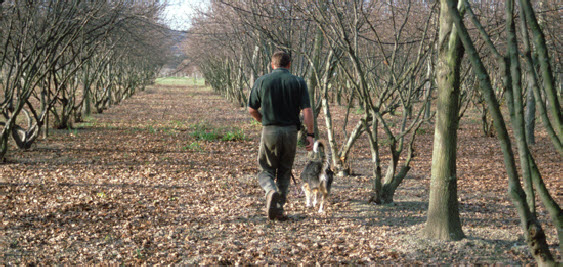
Truffles, mushrooms and mycorrhizas
© Truffles and Mushrooms (Consulting) Ltd
About us
In 1979 while working at Invermay near Dunedin for the research arm of the New Zealand Ministry of Agriculture & Fisheries, Dr Ian R. Hall had the idea of cultivating truffles in New Zealand for the Northern Hemisphere off-season markets. Initially he met considerable resistance but when Dr Jock Allison was appointed as Director in 1985 Dr Hall was finally allowed to begin research. Within 18 months he and Sharon Roberts, his part-time technician, developed a method for producing Périgord black truffle ( Tuber melanosporum) mycorrhized plants and a year later three experimental truffières (truffle plantations) were established in North Otago, New Zealand (45°S). The following year 3000 additional truffle mycorrhized hazelnuts (Corylus avellana) and common oaks (Quercus robur) were produced and a further 8 truffières were established between the Bay of Plenty (38°S) and North Canterbury (43°S). The first Périgord black truffles were produced near Gisborne (38.5°S) in 1993 where the first commercial harvest was made in 1997. The bianchetto truffle (Tuber borchii), Burgundy truffle (Tuber aestivum) and the saffron milk cap mushroom (Lactarius deliciosus) were introduced in the late 1990s.
Truffles & Mushrooms (Consulting) Ltd and Symbiotic Systems New Zealand Ltd were established after Dr Ian R. Hall decided to leave Crop & Food Research in 2003. Truffles & Mushrooms (Consulting) Limited now advises internationally on methods for the cultivation of truffles and other ectomycorrhizal mushrooms, and the exploitation of the beneficial effects of mycorrhizas in forestry, horticulture, and agriculture .
Truffles in New Zealand Mycorrhizal mushrooms Soil and site selection
Truffles & Mushrooms (Consulting) Ltd and Symbiotic Systems New Zealand Ltd were established after Dr Ian R. Hall decided to leave Crop & Food Research in 2003. Truffles & Mushrooms (Consulting) Limited now advises internationally on methods for the cultivation of truffles and other ectomycorrhizal mushrooms, and the exploitation of the beneficial effects of mycorrhizas in forestry, horticulture, and agriculture .
Truffles in New Zealand Mycorrhizal mushrooms Soil and site selection
ABOVE Alan and Lynley Hall’s productive Périgord black truffle plantation (truffière) near Gisborne, New Zealand, the first to produce truffles in the Southern Hemisphere .
RIGHT The saffron milk cap - an additional income stream for the forestry industry.
FAR RIGHT Stunted growth and chlorosis of young Douglas fir a few years after planting into upland soils of New Zealand. This can often be traced to a lack of ectomycorrhizal fungi in the soil at the outplant site and a failure to ensure adequate mycorrhizal infection in the nursery. For more information, download our New Zealand MAF Sustainable Farming Fund report:
RIGHT The saffron milk cap -
FAR RIGHT Stunted growth and chlorosis of young Douglas fir a few years after planting into upland soils of New Zealand. This can often be traced to a lack of ectomycorrhizal fungi in the soil at the outplant site and a failure to ensure adequate mycorrhizal infection in the nursery. For more information, download our New Zealand MAF Sustainable Farming Fund report:



